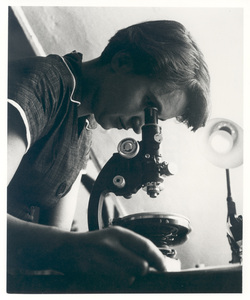 by Yoon Joung Lee A British biophysicist, Rosalind Elsie Franklin, was born in Notting Hill, London in 1920. She is well known for her important contribution to molecular structures, X-ray diffraction, DNA, RNA and viruses. Rosalind was the second one out of five children from an affluent and influential British-Jewish family. She grew up in a very conservative family and her parents believed that girls need an education to get married and they should do charitable social work after marriage. Due to such family’s expectation and belief, Rosalind had some kinds of conflict with her father as she pursued her educations. She excelled with a great talent in Physics and Chemistry while at St. Paul’s Girls’ School in London. She later attended Newnham College, Cambridge, in 1938 and finished her study in 1941 as she was awarded a research scholarship for her work of gas chromatography. In 1942, she started to work on the microstructure of coke at the British Coal Utilization Research Association to work. She received her Doctor of Philosophy (Ph.D) degree from Cambridge in 1945. From 1947 to 1950, she left Cambridge and she went to work with Jacques Mering at the Laboratoire Central des Services Chimiques de L’Etat in Paris to gain experience in X-ray diffraction techniques. There, her work involved the investigation of the changes to carbon fibres when it became graphite on heating. During this time, she published several papers and it became an important part of the work on the physics and chemistry of coal, covered by a current monograph, the annual and other publications. As a result of her contribution and expertise, she got a phone-call from John Randall at King’s College, London. She joined their research group to study DNA fibers using X-ray crystallography. Her responsibility there was determining the structure of DNA. With her knowledge of physical chemistry and controlling the humidity while taking an X-ray photograph, she was able to make thinner fibres, which produce more accurate and easier to interpret X-ray patterns. She also discovered A and B forms of DNA. She focused mainly on A. Although A form showed more X-ray spots, it did not show B form and the helical structure. She started to record her discovery and revised thought in her laboratory notebook. John Randall presented her unpublished current research and data at a routine seminar. Somehow this information was leaked to Watson and Crick. They put all the pieces of the puzzle from various sources including Franklin’s conclusions and data to complete the description of DNA’s structure. Their conclusion for the DNA structure was introduced in the journal Nature in April, 1953. Franklin wrote a supporting article in the same edition. Franklin kept a good friendship with both James Watson and Francis Crick until she finished her work. Her life ended by ovarian cancer in April of 1958. She was 37. After her death, she left a reputation around the world for her great contribution to the structure of carbon compounds and of viruses. However, what made many people sad was that she was not given credit she deserved for her works in the discovery of the structure of DNA. |
Archives
July 2017
Categories
All
|
 RSS Feed
RSS Feed